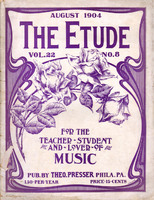H.—Tschaikowsky’s “Troika en Traineaux,” Op. 37, No. 11, has not been described programmatically so far as we are aware. The title refers to the Russian sleigh.
A. M. P.—We advise against a teacher, no matter how good a pianist, giving lessons on the violin without having given considerable study to its mastery. To become a good violin player requires more than a knowledge of music; the technic of violin-playing is very different from that required for the violin.
E. C. B.-We have consulted some standard editions and find the following metronome markings recommended for the pieces named: Beethoven, Op. 2, No. 3, Allegro, 144 quarters to the minute; Adagio, 51 eighths; Scherzo, 76 dotted half notes; the minore a little slower, 66; Allegro Assai, 112 dotted quarters. Op. 7, Allegro Molto, 126 dotted quarters to the minute; Adagio, 51 eighths; Scherzo, 76 dotted half notes; the minore slower, only 66; Rondo, 60 quarters. Op. 14, No. 1, Allegro, 138 quarters to the minute; Allegretto, 60 dotted half notes; Rondo, 76 half notes. Op. 14, No. 2. Allegro, 84 quarter notes to the minute; Andante, 76 quarters; Scherzo, 76 dotted quarters. Op. 27, No. 1, Andante, 84 quarters to the minute; Allegro Molto, 100 dotted half notes; Adagio, 66 eighths; Allegro Vivace, 126 quarters. Op. 27, No. 2, Adagio, 50 quarters to the minute; Allegretto, 76 dotted half notes; Presto, 84 half notes to the minute.
J. W. S.—The hair of the double bass bow is not laid flat on the strings, but on the edge nearest the player. When pressure is applied to the bow the full width of the hair is forced on the strings. The length of the bow is about twenty-eight inches. You can secure a very good method in the Novello Music Primer Series, White’s, which retails for $1.20.
N. S. S.—1. You should cultivate an easy, relaxed condition of the arms. With the arm in a contracted condition no satisfactory finger work can be done.
2. The shaping of the hand and the proper position of the fingers would best be accomplished away from the keyboard at a table. Do no keyboard work until the correct conditions and position are attained.
3. In the “Principles of Expression in Pianoforte Playing,” by Christiani, many valuable hints on phrasing may be found, together with other interesting and practical material. Franklin Taylor’s “Primer of Pianoforte Playing” also has some good ideas on the subject, and Goodrich’s “Theory of Interpretation” will be found helpful.
L. E. B.—Köhler’s Studies, Op. 151, may be followed by Engelmann’s “Selected Primary Studies,” Book I, or L. Schytté, Op. 108. Duvernoy, Op. 120, Book I, should be supplemented by the same volume arranged for left hand by Erb, notice of which will be found in the Publisher’s Notes in this issue. These may be followed by Sartorio’s “Velocity Studies.” The “First Study of Bach” may be begun in conjunction with the work of Grade III, and forms an introduction to the classics and to polyphonic playing. Mason’s “Touch and Technic,” Books I and II, may be used in conjunction with the foregoing studies.
A. B.—The Cramer Etudes are an admirable preparation for the “Gradus ad Parnassum” by Clementi. Many teachers use the “Inventions” of Bach between these two works. We think this an excellent plan. The “Suites” of Bach generally follow the “Inventions.” They will be found complete in one volume of the Steingräber Edition. Bach’s “Lighter Compositions,” edited by Kullak, will be found to contain an admirable selection of numbers from the “Inventions,” the “Suites,” and the
“Little Preludes.” This volume may be used instead of the “Inventions.” The sonatas of Mozart and Haydn may be introduced with Cramer, Book I, or even a little earlier, but the easier ones must be selected. There is a work in double thirds and sixths by Moszkowski, which is exhaustive.
O. S.-We give below a list of some of the best-known and most-popular works of the composers mentioned in your query: Bach, Fugue in D, from the “Well-Tempered Clavichord”; the “Italian Concerto”; Gavottes in E major and B minor. Beethoven, Sonatas, Op. 13; Op. 26; Op. 27, No. 2. Chopin, Mazurka, Op. 7, No. 1; Valse, Op. 34, No. 3; Nocturne, Op. 9, No. 2; Polonaise, Op. 40, No. 1; Etude, Op. 10, No. 5; Funeral March, from Op. 35. Field, Nocturne in B-flat. Handel, the “Harmonious Blacksmith”; Suite in D minor. Haydn, Sonata in E-flat; “Gypsy Rondo.” Mendelssohn, “Spring Song”; “Spinning Song”; Capriccio in A minor; Prelude and Fugue in E minor. Mozart, Fantasia in D minor, Fantasia and Sonata in C minor. Schubert, Impromptu in B-flat, Op. 142, No. 3; Minuet in B minor; Military March (Tausig’s Transcription). Schumann, Nachtstück, Op. 23, No. 4; Warum? Op. 12, No. 3; Aufschwung, Op. 12, No. 2; Papillons and Carnival. Weber, Perpetual Motion (Rondo); Sonata in A-flat. While this list is by no means exhaustive, the compositions mentioned above will be found in the permanent repertories of most pianists and teachers.



